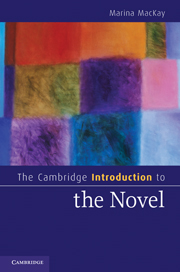Book contents
- Frontmatter
- Contents
- Acknowledgments
- About this book
- Chapter 1 Why the novel matters
- Miguel de Cervantes, Don Quixote (1605, 1615)
- Chapter 2 Origins of the novel
- Laurence Sterne, The Life and Opinions of Tristram Shandy, Gentleman (1759–67)
- Chapter 3 Narrating the novel
- James Hogg, The Private Memoirs and Confessions of a Justified Sinner (1824)
- Chapter 4 Character and the novel
- Nathaniel Hawthorne, The Scarlet Letter (1850)
- Chapter 5 Plotting the novel
- Gustave Flaubert, Madame Bovary (1857)
- Chapter 6 Setting the novel
- Charles Dickens, Bleak House (1853)
- Chapter 7 Time and history
- Virginia Woolf, To the Lighthouse (1927)
- Chapter 8 Genre and subgenre
- Graham Greene, The Ministry of Fear (1943)
- Chapter 9 Novel and anti-novel
- Thomas Pynchon, The Crying of Lot 49 (1966)
- Chapter 10 Novel, nation, community
- Salman Rushdie, Midnight's Children (1981)
- Chapter 11 Concluding
- Notes
- Glossary
- Further reading
- Index
- Cambridge Cultural Social Studies
Chapter 5 - Plotting the novel
Published online by Cambridge University Press: 05 June 2012
- Frontmatter
- Contents
- Acknowledgments
- About this book
- Chapter 1 Why the novel matters
- Miguel de Cervantes, Don Quixote (1605, 1615)
- Chapter 2 Origins of the novel
- Laurence Sterne, The Life and Opinions of Tristram Shandy, Gentleman (1759–67)
- Chapter 3 Narrating the novel
- James Hogg, The Private Memoirs and Confessions of a Justified Sinner (1824)
- Chapter 4 Character and the novel
- Nathaniel Hawthorne, The Scarlet Letter (1850)
- Chapter 5 Plotting the novel
- Gustave Flaubert, Madame Bovary (1857)
- Chapter 6 Setting the novel
- Charles Dickens, Bleak House (1853)
- Chapter 7 Time and history
- Virginia Woolf, To the Lighthouse (1927)
- Chapter 8 Genre and subgenre
- Graham Greene, The Ministry of Fear (1943)
- Chapter 9 Novel and anti-novel
- Thomas Pynchon, The Crying of Lot 49 (1966)
- Chapter 10 Novel, nation, community
- Salman Rushdie, Midnight's Children (1981)
- Chapter 11 Concluding
- Notes
- Glossary
- Further reading
- Index
- Cambridge Cultural Social Studies
Summary
“If you judge by appearances in this place,” said Mme de Chartres, “you will often be deceived, because what appears to be the case hardly ever is.”
Madame de Lafayette, The Princess of Clèves (1678)“Hale knew, before he had been in Brighton three hours, that they meant to murder him.”
Graham Greene, Brighton Rock (1938)These lines from two very different novels remind us, first, that a “plot” is a conspiracy as well as the organization of a narrative, and, second, that fictional plots, like their criminal counterparts, depend on secrecy and withholding. Although it takes the form of a declarative statement, the crisp opening of Brighton Rock works only to elicit questions; it doesn't so much inform us of what's going on as it reminds us of what we don't know yet: Who is “Hale”? Who are “they”? And why do they want to murder him? One of the pleasures of reading novels is the detective work of piecing information together to see below surfaces (“what appears to be the case hardly ever is”), with the confidence that we will end the novel having achieved some form of clarity and revelation. When critics speak of readerly investment, they're describing how we are motivated to keep reading, how we “invest” in a novel in the expectation of a later reward. This chapter describes the tactics through which novels ask us to defer our gratification, to give our time and attention in the assurance of future disclosure.
- Type
- Chapter
- Information
- The Cambridge Introduction to the Novel , pp. 83 - 94Publisher: Cambridge University PressPrint publication year: 2010

